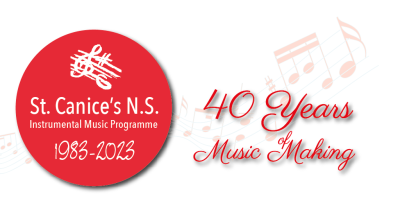The instruments in this family all used to be made of wood, which gives them their name. Today, they are made of wood, metal, plastic or some combination. They are all basically narrow cylinders or pipes, with holes, an opening at the bottom end and a mouthpiece at the top. You play them by blowing air through the mouthpiece (that’s the “wind” in “woodwind”) and opening or closing the holes with your fingers to change the pitch. Metal caps called keys cover the holes of most woodwind instruments.
Alto Saxaphone
The video shows Daire Maher 6th Class 2013-2014 interviewed and performing in Senior Orchestra in the programme “Meet The Orchestra” recorded in May 2013 and aired on RTE Junior in September 2013
The saxophone is a member of the woodwind family and is made almost entirely of metal. The sound is produced by a vibrating single reed which is the same sound producing method as a clarinet. The clarinet and saxophone are similar in many ways.
All instruments are members of a small family of instruments that come in various shapes and sizes. The saxophone family has basically four members. The Bb (B flat) soprano, Eb alto, Bb tenor and Eb baritone saxophones are all widely used. The most popular and best beginning instrument is the Eb alto saxophone. A student with very large hands can succeed with a Bb tenor saxophone but alto is usually preferred. The soprano and baritone saxophones are played by advanced players who probably started out with an alto saxophone.
The saxophone comes in three pieces plus a reed and a ligature. The ligature is the clamp that hold the reed in place around the mouthpiece. The reed is the most delicate portion of the instrument. It’s very easy to chip a reed by bumping the mouthpiece on a music stand or clothing. Once a reed is damaged or worn out, it needs to be replaced. Students who are very careful with their reeds will still need several replacement reeds to get them through a year of playing.
All reeds are given a rating of strength, “1” through “5”. The lower the number, the softer the reed. In general, the stronger or stiffer reeds are used by advanced players. Teachers have different opinions on the best reed strength for beginners. The most commonly held belief is that beginners should start with a number “2” reed. A number “1” is too soft. Players advance to higher numbers as their performance level and lip muscles develop.
The saxophone is played with the left hand closest to the mouth. The right hand covers the lower keys. Since the saxophone is the only woodwind instrument made of brass, it is capable of very loud sounds by a beginner. With practice, a player can produce a very soft and sweet sound.
The saxophone is a very widely used instrument. They play a critical role in bands, jazz groups and small instrumental groups. It’s a relatively new instrument compared to others. It is especially common to see a number of saxophones of various sizes in jazz groups. Professional jazz saxophonists tend to play more than one saxophone. They may own and perform on the soprano, alto, tenor and baritone saxophones as well as the clarinet.
St Canice’s saxophonists perform in the Junior orchestra, Senior orchestra and Jazz band and may also get together with fellow woodwind, string or brass players to form smaller performing groups.
All instruments have limited availability and will be distributed for hire on a first come first served basis. Saxophones are available for hire for two years. Lesson costs depend on the size of the group being taught and can alter annually. Please ask for further details.
